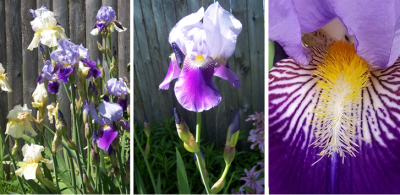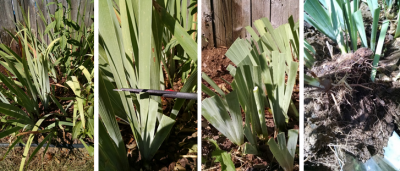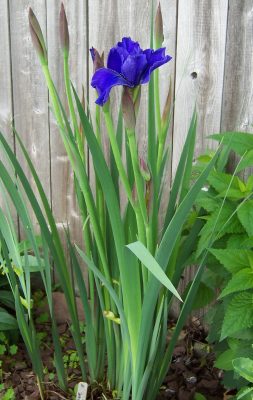Iris
Irises, in the family Iridaceae, are popular ornamental herbaceous perennials with complex, erect, showy flowers. Irises may grow from creeping rhizomes or subterranean bulbs but the varieties discussed here are rhizomatous. Rhizomes are modified underground storage structures that are actually horizontal stems with nodes, shoots, buds, and scales. The enlarged areas of rhizomes are called stem tubers and in the iris plant they lay along the soil surface. The sword-shaped leaves at the base of the iris plant grow from the stem tubers. When irises are divided each piece of the rhizomatous tuber is capable of becoming a new plant.
The flower of irises is six-lobed and symmetrical but with an unusual arrangement atop a tall stem. Three true petals stand upright and are called standards. The other three ‘petals’ are actually modified leaves, also known as sepals, and they droop down and outwards and are called falls. The design of the iris blossom, with horizontal sepals and a bright central blotch where they connect, is very inviting to pollinators. The forward movement of the pollinator opens a small hinged flap of the stigma while pollen collects on the back of the insect. As the insect backs out of the stigma, the flap closes so that none of the new pollen falls in, preventing self-pollination. The insect’s visit to the next iris will allow the pollen from the first flower to be deposited into the stigma of the second flower, completing cross-pollination. Cross-pollination allows for more diversity in the species.
Classifications
The American Iris Society divides irises into three main classifications: Bearded, Aril, and Beardless Irises. In general, the Bearded and Siberian varieties are the most suitable irises for Connecticut gardens.
Bearded Irises
Bearded irises are native to central and southern Europe. The “beards” in the center of the lower falls are the short, tufted, filament portion of the stamen. Bearded iris bloom in the spring and early summer, prefer well-drained soils and sunny locations.

The bare rhizomes should be planted in the late summer and divided every 2-3 years as they become congested. (See Dividing Irises below.) There are some varieties that may repeat bloom from late July to October with summer fertilization. Bearded irises are subdivided into six groups based on height and bloom time:
| Variety | Height | Bloom Time | Comments |
| Miniature Dwarf Bearded (MDB) | 2 to 8 inches | Spring bloomers | Rock gardens or drift plantings. |
| Standard Dwarf Bearded (SDB) | 8 to 15 inches | Late spring bloom as MDBs are fading | Plant in clumps. |
| Intermediated Dwarf Bearded (IB) | 16 to 28 inches | Late spring-summer bloomers | Clump or individual specimen plantings. |
| Border Bearded (BB) | 16 to 28 inches | Summer bloomers | Similar to IB in height but blooms with the TB. Round, ruffled petals. |
| Miniature Tall Bearded (MTB) | 16-28 inches | Summer bloomers | Thin, wiry stems and smaller blooms than BB. Round, ruffled petals, also known as table iris as they are useful in arrangements. |
| Tall Bearded (TB) | 27 to 40 inches | Summer bloomers with a wide variety of colors and patterns | Branching with many buds, frequently lacy or ruffled. |
Aril Irises
Aril irises are native to the Near East and have large, strongly marked flowers. They are bearded irises although they have sparse or straggly beards. Arils grow in hot dry climates and prefer to be planted in shallow, well-drained soil. It is not the cold of winter that makes Connecticut unsuitable for Oncocyclus arils but the level of rainfall. Oncocyclus cannot tolerate water during their summer dormancy period. The Regalia arils are less likely to rot during their summer dormancy if the soil has adequate drainage or they are planted on slopes or in raised beds. Arils are subdivided into two groups:
| Variety | Height | Bloom Time | Comments |
| Oncocyclus: Cushion irises | 6 to 19-inch stems | Late spring | Single blooms. |
| Regalia: Royal irises | 9 to 22-inch stems | Late spring-summer | Often 2 blooms on each stem. |
Hybrids produced from crossing arils and other common breeds of bearded irises are called arilbreds (AB) and can be grown wherever bearded iris flourish. Arilbreds are tall with showy blooms in the late spring.
Bearded Iris Planting and Care
Planting
Bearded irises are non-native to North America but they do not become aggressive or invasive. They grow in zones 3 to 9. Most varieties grow best in full sun (6+ hours a day) although some do well in partial shade. Optimum pH is 6.5 to 7. Bearded irises tolerate a range of soils from loam to clay but planting sites must be well drained. Bearded irises are planted in the late summer or early fall. Soak the rhizomes and root in water for a few hours before planting. The hole should be 6 to 8-inches deep with a central mound and spaced about 18 inches apart. Place the rhizome on top of the mound so that it is level with the ground and the roots spread out and down. The rhizome must be exposed to the sun to reduce the potential of rot. The top of the rhizome should be barely covered with soil. Water immediately after planting. Do not mulch as it may encourage the rhizomes to rot.
Fertilization
Fertilize lightly with a low nitrogen fertilizer such as 5-10-5-, 5-10-10, or 6-24-24 in fall. Apply fertilizer around the plant, not on the rhizome. Do not over-feed.
Deadheading and Pruning
Individual flowers should be deadheaded, leaving any unopened buds on the stem. Spent blooms look soggy and unattractive and will form seed pods if left on their stems. Seed pods should be removed. When all the flowers have blossomed, cut the stalk down to where it emerges from the leaves. Do not remove green leaves as they provide nutrition for the plant but they can be cut back to the ground when they turn brown. Cut all foliage down to 1 to 2 inches after a killing frost in the fall and remove all debris from area. Bearded irises are susceptible to rot.
Division
Plants should be divided every 3 to 4 years after flowering (in late July or August) to promote vigorous growth. Cut the leaf fans back to 6 inches (doing this first makes it easier to dig up the plant). Dig up entire clump and rinse off any soil. Inspect rhizomes for signs of rot or iris borer. Discard old, borer-infested, smelly, or mushy rhizomes and save the healthy ones. Separate with a sharp knife that has been dipped into a 1:10 bleach/water solution between cuts or gently break apart healthy rhizomes by hand so that each section has 1-2 leaf fans. Trim roots to 6 inches. Replant immediately in a shallow hole or dry and store them in cool dry place for until ready to replant. Spread roots out horizontally when replanting.


Beardless irises are subdivided into six classes:

| Variety | Height | Bloom Time | Comments |
| Spuria, Iris spuria (SPU) | 2 to 5 feet tall | Blooms late-spring to mid-summer | Grows in well-drained soil. Narrow reed-like foliage with blooms in a variety of colors that often resemble orchids. Dislikes being transplanted if the rhizome or roots are allowed to dry out. Attractive in clumps. |
| Siberian, Iris sibirica (SIB) | 2 to 4 feet tall | Late-spring to early-summer bloom | Grows best in wet soil in colder climates. Slender, grass-like leaves and branching stems with 2 to 5 delicate, violet blue, blue, or occasionally white blossoms. Attractive in clumps. |
| Japanese, Iris ensata (JA) | 2 to 4 feet tall | Late summer | Huge blooms that are ruffled or flat in shape in blue, lavender, violet-red, pink, or white. Requires slightly acidic, well-drained soil. |
| Louisiana, Iris ser. Hexagonae (LA | 2 to 5 feet tall | Spring | Also known as swamp iris it grows along the American Gulf Coast in wet, acidic soil. |
| Pacific Coast Natives or Iris ser. californicae (PCN) | 1 to 2 feet tall | Early to late spring | Grows on the Pacific coast of the US and is intolerant of other climates. |
| Species Iris (wild): Iris confusa, I. missouriensis, I. tectorum, I. versicolor |
Varied | Late spring | This group includes Blue Flag irises. Useful in wet areas. |
Beardless Iris Planting and Care
Planting
Beardless irises grow in zones 3 to 9, preferring full sun. The soil should be well-drained to slightly moist and the pH should be slightly acidic, in the 5.5 to 6.5 range. Soak rhizomes in water overnight before planting. Dig a 10-inch hole, with a central mound so that the buried rhizome is 2 to 3 inches below ground. Beardless irises can be mulched lightly as they are less prone to diseases and pests than the bearded varieties.
Fertilization
Beardless irises require more fertilization than bearded varieties. A low-nitrogen fertilizer such as 5-10-5-, 5-10-10, or 6-24-24 should be applied at planting and then each spring. Apply fertilizer around the plant, not on the rhizome. Do not over-feed.
Deadheading and Pruning
Beardless irises do not need to be deadheaded. The seed heads are attractive and some may be left in place. As with bearded irises, brown or diseased leaves should be removed immediately. Foliage turns an attractive yellow in the fall and can be cut down to 1 to 2 inches after killing frost or left for winter color and then cut back in early spring.
Division
Beardless iris plants do not need to be divided as often as the bearded types, some clumps may go 10-12 years before division is required. When the central portion of clump does not grow well or the size and quality of the blooms has diminished it is time to divide. Division can be done in April. Large clumps may have to be dug up with a pitchfork or sharp spade. Separate clumps into pie-shaped wedges with a sharp knife or spade that has been dipped into a 1:10 bleach/water solution between cuts. Trim roots to 6 inches. Replant immediately 2-3 inches below ground level or allow rhizomes to dry and store them in cool dry place for until ready to replant. See images under Bearded iris division section.
Dwarf Crested Iris
Dwarf crested iris, Iris cristata, is a native perennial of North America and is hardy in zones 4 to 8. Dwarf crested iris is found in woodlands where it forms a low carpet of easily spreading plants. The 3 to 6-inch tall plants has blooms in shades of pale blue and purple with white and yellow markings from mid to late-spring. They sit on very short stems and have narrow, sword-shaped yellowish-green leaves. It is a rhizomatous iris that prefers a well-drained soil and part shade. If planted in full sun the dwarf crested iris will require constant moisture.
Iris Diseases and Pests
Bacterial Soft Rot
The bacterial infection, Erwinia carotovora, is a soft rot that can affect bearded iris. It enters the plant through cuts in the rhizome or insect feeding. A bad-smelling yellow ooze is seen in the rhizome and the base of the leaves. This problem is best prevented by proper planting and growing techniques to prevent wet rhizomes. Infected rhizomes usually have to be removed.
Leaf Spot
Iris infected with leaf spot exhibit spots that have brown circular margins with yellow centers. Cut off and destroy any leaf or part of a leaf that is infected. If this becomes a serious problem, spraying with a copper fungicide 6 weeks before bloom in the spring can be effective. Leaf spot is caused by excessive moisture from irrigation and rainy humid weather.

Failure to Bloom and Reblooming
Failure to bloom is also called diminished bloom. This is usually a symptom of overcrowding, particularly when noted in the central clump. Dividing every 3-4 years is recommended. Other causes include inadequate sunlight and high nitrogen fertilizer.
Iris Borers
The adult insect, a small gray moth lays eggs on old foliage in the late summer. In the spring, the larvae hatch and migrate into leaves and down into the rhizome. As the borers feed, saw tooth leaf edges may be seen in early spring. The foliage turns yellow and buds may turn brown and watery. Eventually, the rhizome rots and the plant collapses. The full-grown borers are brownish-yellow with a reddish-brown head. They are over an inch long.

The best way to avoid iris borers is to clean up debris in the early spring before the last frost. This removes over wintered eggs and prevents them from hatching into larvae. Eggs hatch and migrate into leaves when the temperature first reaches 72ºF. Beneficial nematodes are active against the larvae and can be used at this time. By the time the tall bearded irises start to bloom the large are too large to be controlled.
Deer Resistance
Iris species are occasionally to rarely consumed by deer although they will eat almost any plant if they are very hungry.
Despite good cultural practices, pests and diseases at times may appear. Chemical control should be used only after all other methods have failed. For pesticide information or other questions please call toll free: 877-486-6271.
UConn Home and Garden Education Center, 2019